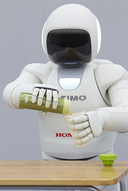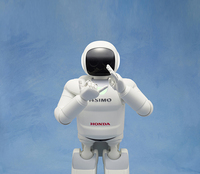New Honda ASIMO Robot Equipped with "Significant Advancements" +VIDEO
HONDA ROBOTICS established as new collective name to represent Honda robotics research and all product applications
TOKYO - November 12, 2011: This week Honda unveiled an all-new ASIMO humanoid robot newly equipped with the world’s first* autonomous behavior control technology. With a further advance in autonomy, the all-new ASIMO can now continue moving without being controlled by an operator. Moreover, with significantly improved intelligence and the physical ability to adapt to situations, ASIMO took another step closer to practical use in an office or a public space where many people come and go.
Since the establishment of the company, Honda has continued to take on new challenges in the effort to create new products and advance technologies with the spirit of utilizing technology to help people. In the area of humanoid robot research, Honda has been developing and advancing the ASIMO humanoid robot to realize a dream to be useful for people and to help enrich people’s daily lives.
• SEE ALSO: Living With Robots
Honda has a newly established collective name, Honda Robotics, to represent all of its robotics technologies and product applications created through its research and development of humanoid robots. While continuing the research and development of humanoid robots, Honda will also focus on applying robotics technologies to mass-produced products and putting product applications into practical use.
Based on this concept of Honda Robotics, Honda also introduced an experimental model of a task-performing robot arm that was developed while applying multi-joint simultaneous orbit control and posture control technologies amassed through the research and development of ASIMO. This robot arm can be remotely controlled to perform tasks in unstable places which are difficult for people to access.
*Honda internal research (as of November 8, 2011)
• All-new ASIMO
The all-new ASIMO is now advanced from an “automatic machine” to an “autonomous machine” with the decision-making capability to determine its behavior in concert with its surroundings such as movements of people. At the beginning of the development process, the following three factors were identified as necessary for a robot to perform as an autonomous machine, and the technologies required to realize these capabilities were developed; 1) high-level postural balancing capability which enables the robot to maintain its posture by putting out its leg in an instant, 2) external recognition capability which enables the robot to integrate information, such as movements of people around it, from multiple sensors and estimate the changes that are taking place, and 3) the capability to generate autonomous behavior which enables the robot to make predictions from gathered information and autonomously determine the next behavior without being controlled by an operator. With these capabilities, the all-new ASIMO takes another step closer to practical use in an environment where it coexists with people.
Watch the latest ASIMO video with robot enhancements
1. Advancement of intelligence capability
 Recognizing the different voices of three people who are speaking simultaneously |
Honda has developed a new system that is a fundamental technology for advanced intelligence, which comprehensively evaluates inputs from multiple sensors that are equivalent to the visual, auditory, and tactile senses of a human being, then estimates the situation of the surrounding environment and determines the corresponding behavior of the robot. With this technology, ASIMO became capable of responding to the movement of people and the surrounding situations. For instance, ASIMO will stop its current action and change its behavior to accommodate the intention of the other party. Moreover, coordination between visual and auditory sensors enables ASIMO to simultaneously recognize a face and voice, enabling ASIMO to recognize the voices of multiple people who are speaking simultaneously, which is difficult even for a human being to accomplish.
Further, ASIMO is now capable of predicting the direction a person will walk within the next few seconds based on information from pre-set space sensors and quickly determining to take an alternate path to avoid a collision with the person if the estimated locations of the person and the ASIMO intersect.
2. Advancement of physical capability
 Grabbing a water bottle, opening the top and pouring the drink into a cup |
The combination of strengthened legs, an expanded range of leg movement and a newly developed control technology that enables ASIMO to change landing positions in the middle of a motion has enabled ASIMO to walk, run, run backward, hop on one leg or on two legs continuously. As a result of acquiring the ability to make such agile motions, ASIMO has become capable of more flexibly adapting to changing external situations so that it can, as an example, walk over an uneven surface while maintaining a stable posture.
3. Improved task-performing capability
Honda has developed a highly functional compact multi-fingered hand, which has a tactile sensor and a force sensor imbedded on the palm and in each finger, respectively, and which acts to control each finger independently. Combined with the object recognition technology based on visual and tactile senses, this multi-fingered hand enables the all-new ASIMO to perform tasks with dexterity, such as picking up a glass bottle and twisting off the cap, or holding a soft paper cup to pour a liquid without squishing it. Moreover, ASIMO is now capable of making sign language expressions which require the complex movement of fingers.
Key specifications of the all-new ASIMO
| 1. Height | 130cm |
|---|---|
| 2. Weight | 48kg (decreased 6kg from previous model) |
| 3. Operating degrees of freedom | Total: 57 degrees of freedom (increased from previous model) |
| 4. Running speed | 9km/hour (previous model: 6km/hour) |
• Establishing a collective name, Honda Robotics, to represent Honda's robotics technologies and product applications
Studying human beings to understand people and learn from people is the root of Honda’s manufacturing. While positioning the humanoid robot research as one of the important pillars in the area of studying human beings, Honda has been working to realize various functions of a human being that is the ultimate mobility with intelligence.
Honda newly established a collective term, Honda Robotics, and the logo to represent Honda’s robotics technologies and application products created through its research and development of humanoid robot represented by ASIMO.
In addition to the all-new ASIMO and the task-performing robot arm introduced today, the previously introduced the walking assist device with stride management system which supports walking for people with weakened leg muscles, the bodyweight support assist system which reduces the load on legs by supporting part of the bodyweight, and the U3-X, a compact one-wheel-drive mobility device that provides free movement in all directions, are examples of product applications resulting from the application of bipedal technology and balance control technology amassed through the research and development of ASIMO.
Striving to offer next-generation mobility products which expand the joy and fun of mobility, Honda will continue the robotics research that leads to ASIMO, walking assist devices, U3-X and other technologies. In addition, Honda will also work proactively toward putting such product applications into practical use.
Task-performing Robot Arm
Technologies developed for ASIMO were applied to an experimental model of a task-performing robot arm, which moves on a self-propelled base and was designed under the assumption of being utilized at disaster sites or other places too dangerous for people to work. Toward this end, the robot arm was made possible to be remotely controlled to approach the object and stably perform necessary tasks even in a narrow space with unstable footing and many obstacles.
The stability control technology used for ASIMO's walking and running was applied to stabilize the posture of the end of the arm even on an unstable surface so that the robot arm can exert the necessary power output to perform the task. Moreover, the application of other ASIMO technologies such as the compact layout structural designing technique and multi-joint simultaneous orbit control technology that simultaneously controls as many as 57 motors imbedded in the joints of the arms and legs has enabled the robot arm to avoid obstacles and approach an object even in a narrow space with obstacles such as a complicated layout of pipelines.
In the development process, the robot arm is designed to perform the task of opening and closing valves on pipelines; however, it will become capable of performing a variety of tasks by changing the end piece of the arm.
Key specifications of the task-performing robot arm
| 1. Length | 1583mm (arm length) |
|---|---|
| 2. Width | 338mm (base) |
| 3. Depth | 391mm (base) |
| 4. Weight | 29.5kg |
| 5. Operating degrees of freedom | 10 degrees of freedom (including the end piece of the arm) |



